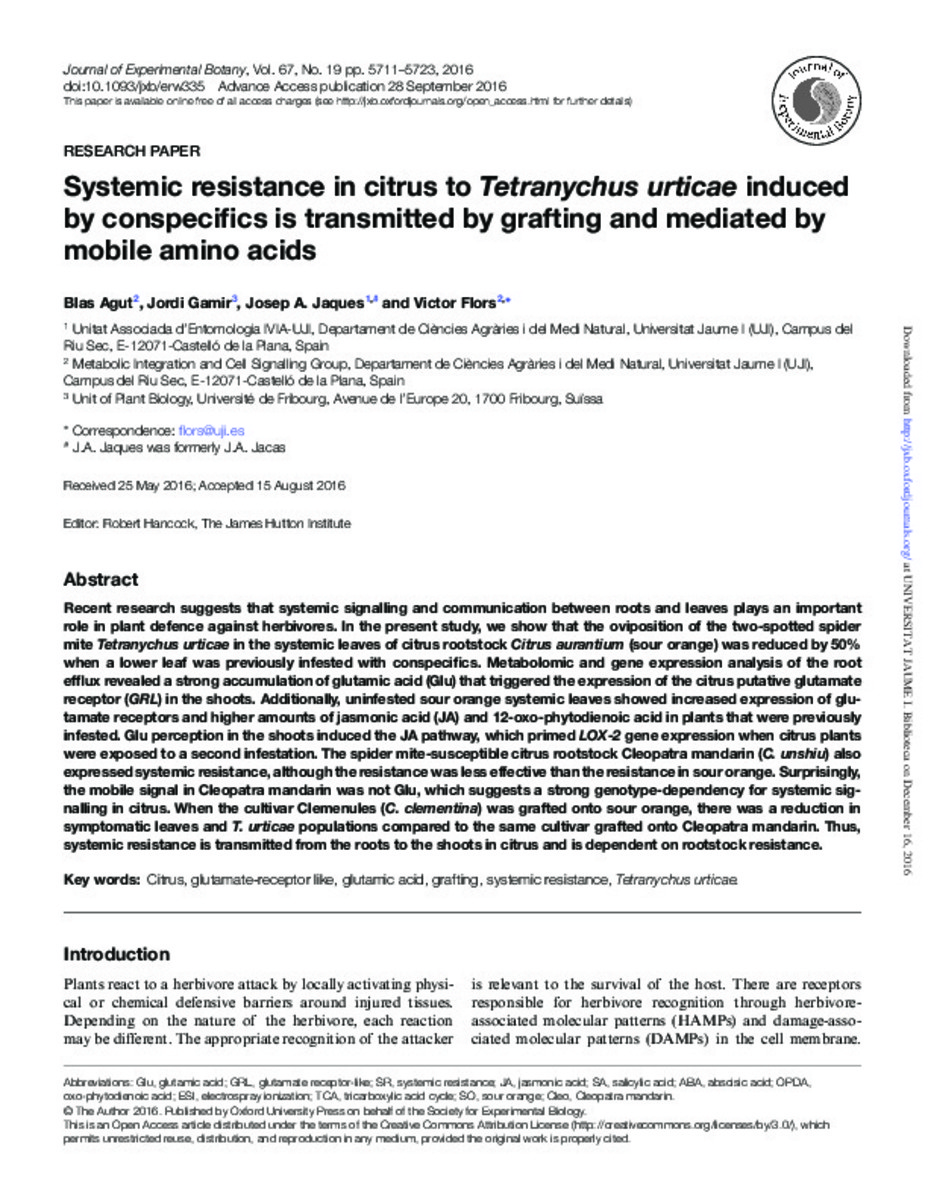Mostrar el registro sencillo del ítem
Systemic resistance in citrus to Tetranychus urticae induced by conspecifics is transmitted by grafting and mediated by mobile amino acids
| dc.contributor.author | Agut, Blas | |
| dc.contributor.author | Gamir, Jordi | |
| dc.contributor.author | Jaques , Josep A. | |
| dc.contributor.author | Flors, Victor | |
| dc.date.accessioned | 2016-12-16T10:19:38Z | |
| dc.date.available | 2016-12-16T10:19:38Z | |
| dc.date.issued | 2016-09 | |
| dc.identifier.citation | AGUT, Blas, et al. Systemic resistance in citrus to Tetranychus urticae induced by conspecifics is transmitted by grafting and mediated by mobile amino acids. Journal of Experimental Botany, 2016, vol. 67, no 19, p. 5711-5723. | ca_CA |
| dc.identifier.uri | http://hdl.handle.net/10234/165070 | |
| dc.description.abstract | Recent research suggests that systemic signalling and communication between roots and leaves plays an important role in plant defence against herbivores. In the present study, we show that the oviposition of the two-spotted spider mite Tetranychus urticae in the systemic leaves of citrus rootstock Citrus aurantium (sour orange) was reduced by 50% when a lower leaf was previously infested with conspecifics. Metabolomic and gene expression analysis of the root efflux revealed a strong accumulation of glutamic acid (Glu) that triggered the expression of the citrus putative glutamate receptor (GRL) in the shoots. Additionally, uninfested sour orange systemic leaves showed increased expression of glutamate receptors and higher amounts of jasmonic acid (JA) and 12-oxo-phytodienoic acid in plants that were previously infested. Glu perception in the shoots induced the JA pathway, which primed LOX-2 gene expression when citrus plants were exposed to a second infestation. The spider mite-susceptible citrus rootstock Cleopatra mandarin (C. unshiu) also expressed systemic resistance, although the resistance was less effective than the resistance in sour orange. Surprisingly, the mobile signal in Cleopatra mandarin was not Glu, which suggests a strong genotype-dependency for systemic signalling in citrus. When the cultivar Clemenules (C. clementina) was grafted onto sour orange, there was a reduction in symptomatic leaves and T. urticae populations compared to the same cultivar grafted onto Cleopatra mandarin. Thus, systemic resistance is transmitted from the roots to the shoots in citrus and is dependent on rootstock resistance. | ca_CA |
| dc.format.mimetype | application/pdf | ca_CA |
| dc.language.iso | eng | ca_CA |
| dc.publisher | Oxford University Press | ca_CA |
| dc.publisher | Society for Experimental Biology | ca_CA |
| dc.relation.isPartOf | J. Exp. Bot. (2016) 67 (19) | ca_CA |
| dc.rights | Copyright © 2016 Society for Experimental Biology | ca_CA |
| dc.rights | Atribución 4.0 España | * |
| dc.rights.uri | http://creativecommons.org/licenses/by-sa/4.0/ | * |
| dc.subject | Citrus | ca_CA |
| dc.subject | glutamate-receptor like | ca_CA |
| dc.subject | glutamic acid | ca_CA |
| dc.subject | grafting | ca_CA |
| dc.subject | systemic resistance | ca_CA |
| dc.subject | Tetranychus urticae | ca_CA |
| dc.title | Systemic resistance in citrus to Tetranychus urticae induced by conspecifics is transmitted by grafting and mediated by mobile amino acids | ca_CA |
| dc.type | info:eu-repo/semantics/article | ca_CA |
| dc.identifier.doi | http://dx.doi.org/10.1093/jxb/erw335 | |
| dc.rights.accessRights | info:eu-repo/semantics/openAccess | ca_CA |
Ficheros en el ítem
Este ítem aparece en la(s) siguiente(s) colección(ones)
-
CAMN_Articles [566]








